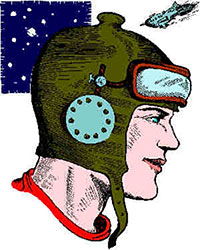 Buck Rogers? The SF character from comicstrips, comicbooks, movies and TV shows? But this blog is about pulp characters. Buck Rogers isn’t a pulp character.
Buck Rogers? The SF character from comicstrips, comicbooks, movies and TV shows? But this blog is about pulp characters. Buck Rogers isn’t a pulp character.
Oh, but he is! While Buck Rogers came to fame due to the long-running comicstrip, which spawned a movie serial, spinoff items, comicbooks, and the later TV show and movie, the character first appeared in the pulp magazines.
He was created by Philip Francis Nowlan and first appeared in the novella “Armageddon 2419 A.D.” in the August 1928 issue of Amazing Stories, and in the sequel novella “The Airlords of Han” in the March 1929 issue.
Soon, John F. Dille of the National Newspaper Syndicate contacted him about getting the rights to the story to create a comicstrip. The character was renamed from Anthony Rogers to Buck Rogers, and the strip kicked off on Jan. 7, 1929, with artwork by Dick Calkins.
Most people have a basic idea of what Buck Rogers is about. Rogers is a man from our time who somehow goes into suspended animation to awaken 500 years in the future to have SF adventures in our solar system and other places, with Wilma Deering (a possible love interest) and super-scientist Dr. Huer, and menaced by, among others, Killer Kane and Princess Ardala. But the details of this have changed with the different versions of the story and characters.
In the original pulp stories, Rogers is a WWI veteran (a captain) and pilot, now investigating abandoned mines in Pennsylvania. In one of them, a pocket of gas preserves him in a state of suspended animation until he awakes 500 years later. The world he finds is very different. It has been conquered by the “Mongols.” America is devastated, its people living in the forests, organized into gangs. We learn that after Rogers went to sleep the European powers united against the U.S. and started a war that devastated both sides (maybe a hint at what lead to WWII). The Soviet Union united with the Mongols against Europe and eventually the Mongols conquered Russia and turned their sights on the U.S. In 2109 they invaded using airships armed with disintegration rays. Soon they built 15 cities across America, leaving the wilds to the conquered Americans.
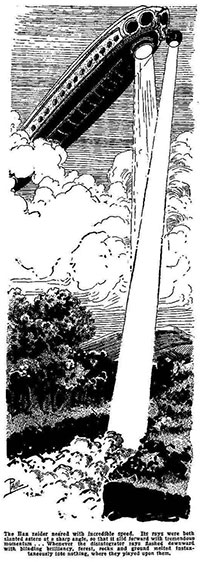 Rogers soon meets Wilma Deering and joins her gang. He also finds that the Americans have developed their own super-science such as inertron, an anti-gravity material that makes “jump belts” and rocket belts possible. Using the military tactics he learned in WWI, he is soon able to turn the tide against the Mongols, or Hans. He eventually becomes the new gang leader and marries Wilma. They then, in conjunction with other gangs, are able to unite against the Mongols and defeat them.
Rogers soon meets Wilma Deering and joins her gang. He also finds that the Americans have developed their own super-science such as inertron, an anti-gravity material that makes “jump belts” and rocket belts possible. Using the military tactics he learned in WWI, he is soon able to turn the tide against the Mongols, or Hans. He eventually becomes the new gang leader and marries Wilma. They then, in conjunction with other gangs, are able to unite against the Mongols and defeat them.
At the end of the sequel, we learn that the Mongols are not actually fully human. In fact, an alien race had crashed in the Gobi Desert and intermarried with humans. These became the warlike Mongols whose super-science conquered the world. A sort of back off from the “Yellow Peril” element of the story.
Comicstrip
The comicstrip initially followed that plot line, but soon started deviating from it. The pulp story was more about military tactics and such, but the comicstrip is more based on adventure and romance. Many of the plot points seem to turn on the jealousy of Wilma (who never marries Buck, but is a sort-of perpetual girlfriend) toward other women attracted to Buck. The comicstrip was a bit of a ground breaker, being one of the first to use continued storylines and also to use speech balloons.
Among the changes in the comicstrip, instead of “gangs,” the groups were called “Orgs,” short for organizations. We soon are introduced to some new characters such as Killer Kane, who is shown as a rival for Wilma. But we know he is a no-good-nick, as he has a mustache and all. He will soon become a reoccurring bad guy for Buck to deal with, even becoming a bit of a Benedict Arnold, as he will work with both America or Earth’s enemies. He would later get Ardala, a lowly female officer and somewhat girlfriend to Kane, to work with him, and she often times pretended to be a Princess and a few times struck out on her own. Dr. Huer, the bald-headed and somewhat absent-minded super-scientist, would soon appear. Bad-guy-turned-good-guy Black Barney also came along later.
In the fight against the Mongols, things go a little different from the pulps. We find out that Niagara, due to the power provided by the waterfall, is unconquered, and it soon becomes the capital of the re-emerging United States of America and Canada.
We find out in one adventure that Mongol rule is not world-wide, when we learn that Argentina is free from the Mongols. And the Americans soon make an alliance with a Mongol freedom group called the Order of the Golden Dragon.
Soon Buck and Wilma are able to met the Mongol Emperor, who turns out to be a nice guy and grants the Americans their freedom, though it seems that it’s only for the eastern half of the U.S.
After a year or so the Mongols are soon forgotten as most story-lines turn to menaces from outer space. In fact, after one mission brings Buck and Wilma back to Earth, we find that there is now a united world government under a president in Niagara! Later it seems that America is more or less back to they way it was, with no Mongols in sight.
A new group that would menace Buck and friends are the Tiger-Men of Mars. We also learn of the Golden People of Mars, who look Nordic. We soon find out that most planets of the solar system have humanoid inhabitants, and even the asteroids have the small Asterites. Occasionally, war will break out from one or another of these groups and Earth, usually the Tiger-Men of Mars. This almost gives them a good stand-in for evil Asians or European powers. And considering the strip running in the time up to WWII and during the war, this makes sense.
The comicstrip lasted from 1929 to 1967. Several people were involved with its creation. Artist Dick Calkins worked on it from 1929 to 1947, eventually replacing Nowlan as the writer about half way through. The great Murphy Anderson worked on it for two two-year periods. Rick Yager wrote and drew it in the 1950s. Then George Tuska drew it in the ’60s, with several writers. A Sunday strip with a separate continuity also ran. During the early years it focused on the adventures of Wilma’s kid brother Buddy and Princess Arista of the Golden People of Mars, before Buck and company took over. Russell Keaton worked on it at first until Yager took over.
Currently Hermes Press is reprinting the comicstrips. They’ve done eight volumes of dailies and two volumes of Sundays, and I wish they’d move faster. I had first read the strips in a big collection from Chelsea House, and want to finally read the conclusion to some of the story-lines they partially reprinted.
Movie serial
Yep, during the time of the movie serials, one Buck Rogers serial was done. Yep, there were changes as Buck and Buddy are flying a dirigible in the arctic and crash. To survive, they release a gas that preserves them.
They wake to a future ruled by Killer Kane and team up with Wilma and Prince Tallum of Saturn (yes, a reoccurring character from the strip). I’ve not seen it, but it’s available.
TV series
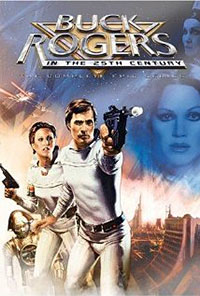 Most people probably remember Buck Rogers from the 1979-81 TV series, created in the wake of “Star Wars.” The pilot episode was also turned into a movie. This series updated Buck for the modern audience.
Most people probably remember Buck Rogers from the 1979-81 TV series, created in the wake of “Star Wars.” The pilot episode was also turned into a movie. This series updated Buck for the modern audience.
Now Captain Rogers is a NASA pilot in a version of the space shuttle that gets frozen in space. Returning to Earth 500 years later, he finds most of it devastated by a nuclear war. It is now ruled out of New Chicago. Wilma is now a colonel (not a lieutenant as in the original comics and pulps) and so his superior officer. This changes the dynamic of these two characters.
Dr. Huer is now head of the Earth Defense Directive. New characters include the AI Dr. Theopolis, usually carried around on the chest of little, annoying robot Twiki. Ardala is now a real princess, ruler of another star empire that is hostile to Earth, with Killer Kane as her main enforcer. The second season tried for a “Star Trek” vibe by sending Buck and company off in a spaceship to find lost Earth colonies.
Comics
Some time in the 1960s, Gold Key Comics (an imprint of Western Publications) did a one-shot Buck Rogers comic. I have not seen it, so can’t comment on it.
The TV series spawned a new comicbook series from Gold Key that was faithful to the TV series. The TV series also encouraged the Dille Syndicate to revise the comicstrip for a run from 1980 to 1983, with artwork by Gray Morrow. The strip is updated to more or less match the TV series, but almost none of the elements unique to the show appear.
Hermes Press has reprinted the comicbook in archive editions and is also reprinting the comicstrip.
Dynamite Comics did a short-lived comicbook series that again updated the storyline and characters. Most of it has been collected in trade paperbacks, except for an annual.
Hermes Press has recently published a comicbook mini-series that revamps the original comicstrip, with story and art by Howard Chaykin. While it still has the Earth conquered by Mongols, he adding in more “modern” explanations. It’s been reprinted in trade paperback.
There has been talk of a new movie for several years.
The original stories are available to those who want to check him out. I’ve been enjoying the comicstrip reprints from Hermes Press, but keep hoping they will move along faster to get to the better stuff by Rick Yager and Murphy Anderson. Find out what all the fuss is about by seeing for yourself.

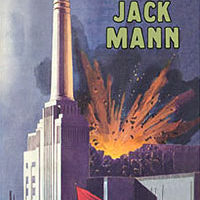

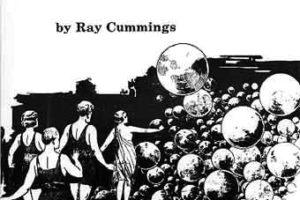
I also had THE COLLECTED WORKS OF BUCK ROGERS IN THE 25th CENTURY from Chelsea House as a kid. My first exposure to the character, and the beginning of a lifelong love affair with the strip.
Praise be to Hermes Press for finally reprinting the strip in its entirety! (At least I hope to live long enough to see its conclusion collected in hardcover.)